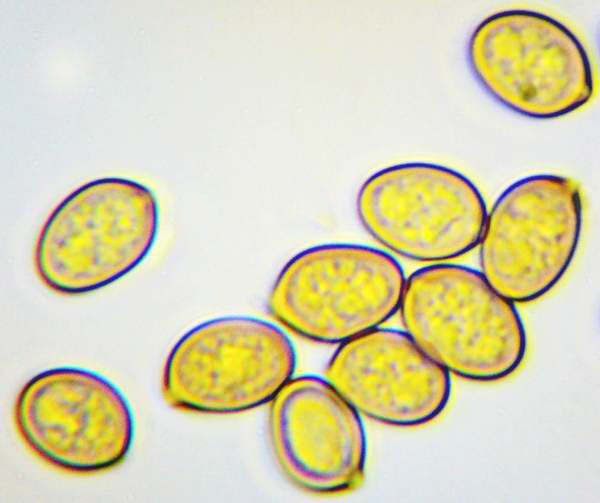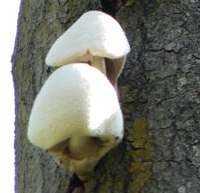Volvariella bombycina (Schaeff.) Singer - Silky Rosegill
Phylum: Basidiomycota - Class: Agaricomycetes - Order: Agaricales - Family: Pluteaceae.
Distribution - Taxonomic History - Etymology - Identification - Culinary Notes - Reference Sources
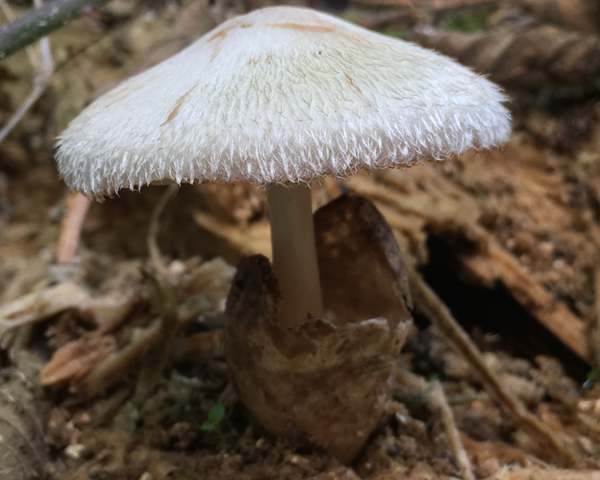
This rare and striking silky-capped mushroom often emerges from knot holes and other damaged areas high up on standing trees. It is not parasitic, and even when seen on living trees it is invariably attached to dead wood.
The scarcity of this mushroom should be enough to convince anyone that this is not a species worth trying to gather for food. In a basket of edible fungi the sight of a white mushroom with a volva should ring alarm bells: some Destroying Angels and Deathcaps can fit this description. In Britain and Ireland no Amanita fungi grow high up in trees, and so if you 'pick your own' the risk to you (other than of falling!) is minimal; however, the rare Silky Rosegill also deserves protection.
Distribution
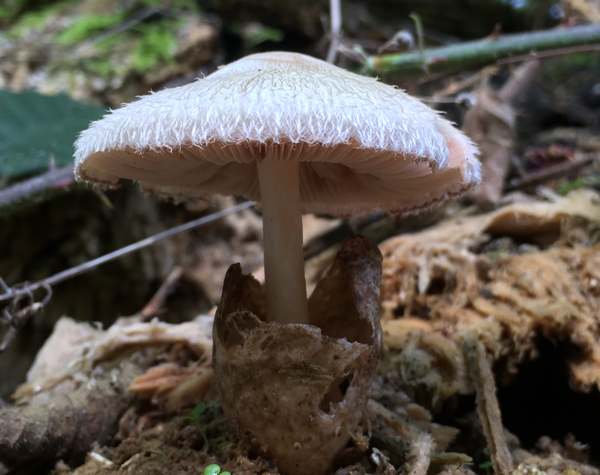
The Silky Rosegill is an infrequent to rare find in Britain and Ireland. This species occurs throughout much of mainland Europe and is recorded also in North America and many other parts of the world.
Taxonomic history
When in 1762 Jacob Christian Schaeffer described this mushroom he gave it the scientific name Agaricus bombycinus. (Most gilled fungi were initially placed in a giant Agaricus genus, now redistributed to many other genera.) It was German-born mycologist Rolf Singer who, in 1949, transferred this species to the genus Volvariella, at which point its binomial scientific name became Volvariella bombycina.
Synonyms of Volvariella bombycina include Agaricus bombycinus Schaeff., and Volvaria bombycina (Schaeff.) P. Kumm.
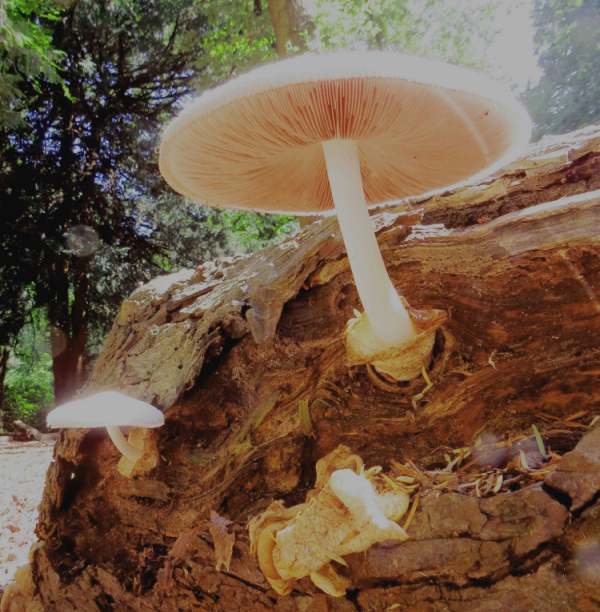
Etymology
Volvariella, the genus name, is a reference to the volva formed around the stem base by the remnants of the membranous universal veil which covers emerging fruitbodies. The specific epithet bombycina comes from the Latin bombycis and means silky. (The scientific name for the silkworm is Bombyx mori, the genus name coming from the same Latin root.)
Identification guide
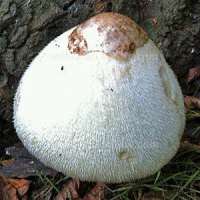 |
CapVery variable in size, from as small as 5cm across to an impressive 20cm, initially egg-shaped and later bell-shaped, often with a slightly inrolled margin even at maturity; white or pale cream, covered in long silky fibres. |
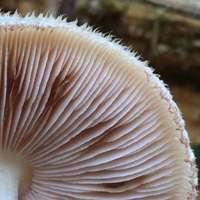 |
GillsFree; crowded; white at first, becoming pink. |
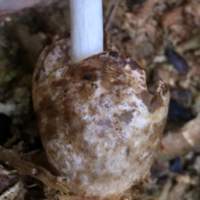 |
Stem and volva7 to 15cm long and 1 to 2cm dia.; white; tapering towards apex; no ring. There is a persistent bag-like volva at the base, initially white but gradually turning yellowish and eventually brown with age. |
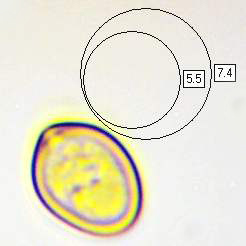 |
SporesEllipsoidal, smooth, 7-10 x 5-6um. Spore printPink. |
Odour/taste |
Odour faintly 'mushroomy' and pleasant; taste not significant |
Habitat & Ecological role
|
Saprobic, on dead deciduous trunks and large branches, particularly of elms, maples and Beech. |
Season |
July to November. |
Similar species |
Volvopluteus gloiocephalus has a smooth silky cap and grows in stubble fields and in grassland. Amanita virosa has a stem ring and occurs on soil in woodland habitats. |
Culinary Notes
The Silky Rosegill is generally regarded as a good edible mushroom. Because this mushroom can easily be confused with deadly Amanita species (such as Deathcap and Destroying Angel) which also have stem-base volvas and pale caps, great care is essential to ensure that there is absolutely no doubt at all about identification. Inexperienced mushroom gatherers should avoid gathering any fungi that have volvas (although in Britain and Ireland the risk is minimised by the fact that there are no Amanita species recorded as growing, as the Silky Rosegill does, on wood rather than on soil).
Reference Sources
Fascinated by Fungi, 2nd Edition, Pat O'Reilly 2016, reprinted by Coch-y-bonddu Books in 2022.
Alfredo Justo, Andrew M. Minnis, Stefano Ghignone, Nelson Menolli Jr., Marina Capelari, Olivia Rodríguez, Ekaterina Malysheva, Marco Contu, Alfredo Vizzini (2011). 'Species recognition in Pluteus and Volvopluteus (Pluteaceae, Agaricales): morphology, geography and phylogeny'. Mycological Progress 10 (4): 453–479.
Orton, P.D. (1986). British Fungus Flora: Agarics and Boleti. Vol 4. Pluteaceae: Pluteus & Volvariella. Royal Botanic Garden: Edinburgh, Scotland.
BMS List of English Names for Fungi
Dictionary of the Fungi; Paul M. Kirk, Paul F. Cannon, David W. Minter and J. A. Stalpers; CABI, 2008
Taxonomic history and synonym information on these pages is drawn from many sources but in particular from the British Mycological Society's GB Checklist of Fungi.
Acknowledgements
This page includes pictures kindly contributed by Simon Harding, Richard Haynes, Matt Leivers and Roy Stewart.
Fascinated by Fungi. Back by popular demand, Pat O'Reilly's best-selling 450-page hardback book is available now. The latest second edition was republished with a sparkling new cover design in September 2022 by Coch-y-Bonddu Books. Full details and copies are available from the publisher's online bookshop...
